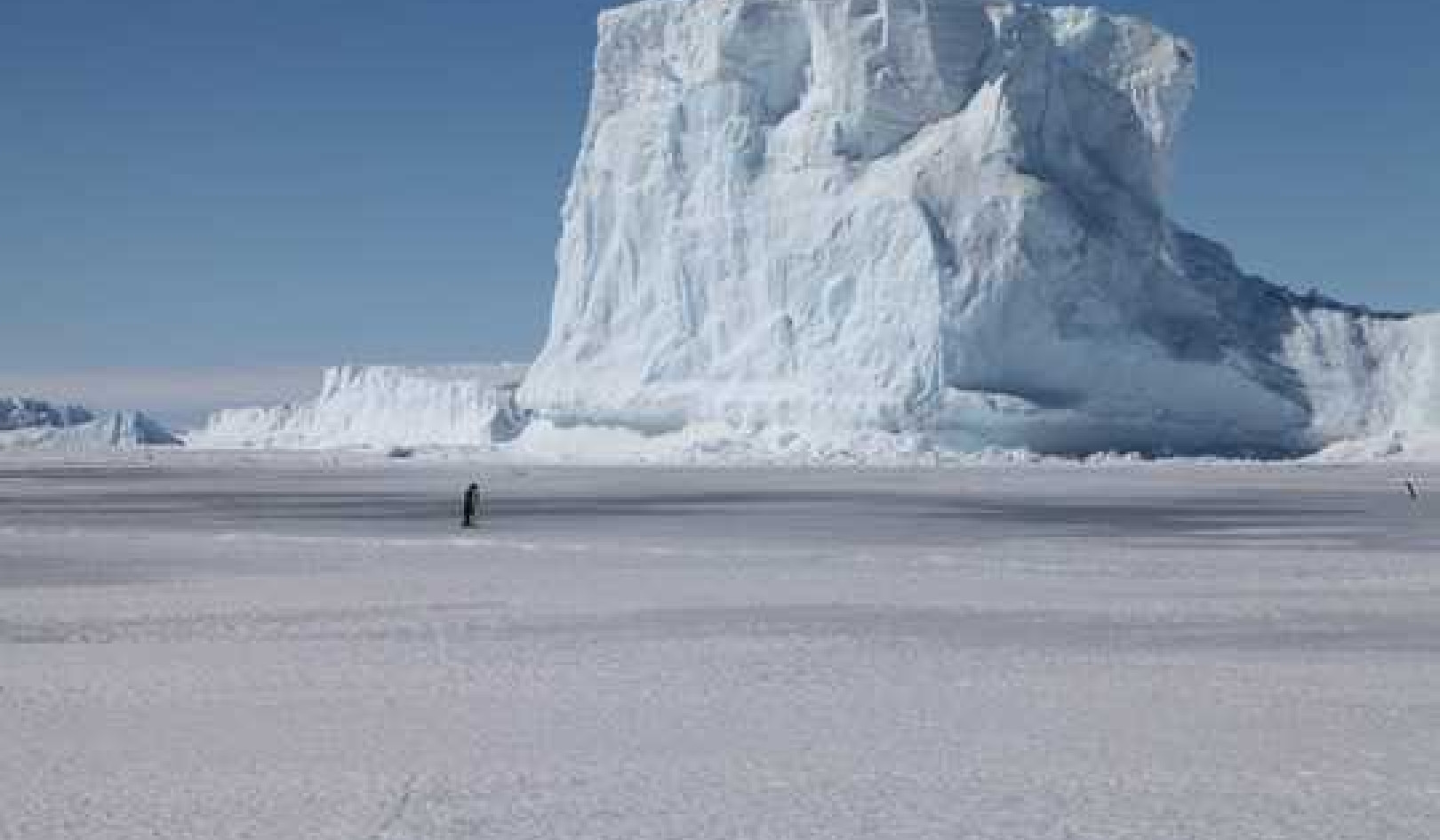 The Pliocene, a geological epoch between two and five million years ago with CO2 levels similar to today, is a good analog for future climate predictions, according to a new study.
The Pliocene, a geological epoch between two and five million years ago with CO2 levels similar to today, is a good analog for future climate predictions, according to a new study.
The Mauna Loa Observatory in Hawaii recently recorded the highest concentration of carbon dioxide levels in human history. The last time CO2 levels surpassed 400 parts per million was during the Pliocene, when oceans surged 50 feet higher and small icecaps barely clung to the poles.
“The Pliocene wasn’t a world that humans and our ancestors were a part of,” says lead author Jessica Tierney, associate professor of geosciences at the University of Arizona. “We just started to evolve at the end of it.”
 A wood engraving by Eduard Riou depicts a landscape view of the Pliocene. The image was etched in the late 1800s, when CO2 levels hovered around 295 ppm. (Credit: Welcome Library)
A wood engraving by Eduard Riou depicts a landscape view of the Pliocene. The image was etched in the late 1800s, when CO2 levels hovered around 295 ppm. (Credit: Welcome Library)
Now that we’ve reached 415 parts per million CO2, Tierney thinks researchers can use the Pliocene to understand the climate shifts of the very near future. Past studies attempted this, but a nagging discrepancy between climate models and fossil data from that part of Earth’s history muddled any potential insights.
The new study in Geophysical Research Letters, which used a different, more reliable type of fossil data than past studies, resolves the discrepancy between fossil data and climate model simulations.
Funky changes
Before the Industrial Revolution, CO2 levels hovered around 280 ppm. For perspective, it took over two million years for CO2 levels to naturally decline from 400 ppm to pre-industrial levels. In just over 150 years, humanity has caused those levels to rebound.
Past proxy measurements of Pliocene sea surface temperatures led scientists to conclude that a warmer Earth caused the tropical Pacific Ocean to be stuck in an equatorial weather pattern called El Niño.
Normally, as the trade winds sweep across the warm surface waters of the Pacific Ocean from east to west, warm water piles up in the eastern Pacific, cooling the western side of the ocean by about 7 to 9 degrees Fahrenheit. But during an El Niño, the temperature difference between the east and west drops to just under 2 degrees, influencing weather patterns around the world, including Southern Arizona. El Niños typically occur about every three to seven years, Tierney says.
The problem is, climate models of the Pliocene, which included CO2 levels of 400 ppm, couldn’t seem to simulate a permanent El Niño without making funky, unrealistic changes to model conditions.
“This paper was designed to revisit that concept of the permanent El Niño and see if it really holds up against a reanalysis of the data,” she says. “We find it doesn’t hold up.”
Fat thermometers for Pliocene temperature
About 20 years ago, scientists found they could deduce past temperatures based on chemical analysis of a specific kind of fossilized shell of a type of plankton called foraminifera.
“We don’t have thermometers that can go to the Pliocene, so we have to use proxy data instead,” Tierney says.
Since then, scientists have learned that ocean chemistry can skew foraminifera measurements, so Tierney and her team instead used a different proxy measurement—the fat produced by another plankton called coccolithophores. When the environment is warm, coccolithophores produce a slightly different kind of fat than when it’s cold, and paleoclimatologists can read the changes in the fat, preserved in ocean sediments, to deduce sea-surface temperatures.
“This is a really commonly used and reliable way to look at past temperatures, so a lot of people have made these measurements in the Pliocene. We have data from all over the world,” Tierney says. “Now we use this fat thermometer that we know doesn’t have complications, and we’re sure we can get a cleaner result.”
‘It all checks out’
The researchers found that the temperature difference between the eastern and western sides of the Pacific did decrease, but not enough to qualify as a full-fledged permanent El Niño.
“We didn’t have a permanent El Niño, so that was a bit of an extreme interpretation of what happened. But there is a reduction in the east-west difference—that’s still true.”
The eastern Pacific got warmer than the western, which caused the trade winds to slacken and changed precipitation patterns. Dry places like Peru and Arizona might have been wetter. These results from the Pliocene agree with what future climate models have predicted, as a result of CO2 levels reaching 400 ppm.
This is promising because now the proxy data matches the Pliocene climate models. “It all checks out,” Tierney says.
The Pliocene, however, was during a time in Earth’s history when the climate was slowly cooling. Today, the climate is getting hotter very quickly. Can we really expect a similar climate?
“The reason today sea levels and ice sheets don’t quite match the climate of the Pliocene is because it takes time for ice sheets to melt,” Tierney says.
“However, the changes in the atmosphere that happen in response to CO2—like the changes in the trade winds and rainfall patterns—can definitely occur within the span of a human life.”
Source: Mikayla Mace for University of Arizona
{vembed Y=jUvJ5ANH86I}
Related Books
Climate Change: What Everyone Needs to Know
by Joseph Romm The essential primer on what will be the defining issue of our time, Climate Change: What Everyone Needs to Know® is a clear-eyed overview of the science, conflicts, and implications of our warming planet. From Joseph Romm, Chief Science Advisor for National Geographic's Years of Living Dangerously series and one of Rolling Stone's "100 people who are changing America," Climate Change offers user-friendly, scientifically rigorous answers to the most difficult (and commonly politicized) questions surrounding what climatologist Lonnie Thompson has deemed "a clear and present danger to civilization.". Available On Amazon
The essential primer on what will be the defining issue of our time, Climate Change: What Everyone Needs to Know® is a clear-eyed overview of the science, conflicts, and implications of our warming planet. From Joseph Romm, Chief Science Advisor for National Geographic's Years of Living Dangerously series and one of Rolling Stone's "100 people who are changing America," Climate Change offers user-friendly, scientifically rigorous answers to the most difficult (and commonly politicized) questions surrounding what climatologist Lonnie Thompson has deemed "a clear and present danger to civilization.". Available On Amazon
Climate Change: The Science of Global Warming and Our Energy Future second edition Edition
by Jason Smerdon This second edition of Climate Change is an accessible and comprehensive guide to the science behind global warming. Exquisitely illustrated, the text is geared toward students at a variety of levels. Edmond A. Mathez and Jason E. Smerdon provide a broad, informative introduction to the science that underlies our understanding of the climate system and the effects of human activity on the warming of our planet.Mathez and Smerdon describe the roles that the atmosphere and ocean play in our climate, introduce the concept of radiation balance, and explain climate changes that occurred in the past. They also detail the human activities that influence the climate, such as greenhouse gas and aerosol emissions and deforestation, as well as the effects of natural phenomena. Available On Amazon
This second edition of Climate Change is an accessible and comprehensive guide to the science behind global warming. Exquisitely illustrated, the text is geared toward students at a variety of levels. Edmond A. Mathez and Jason E. Smerdon provide a broad, informative introduction to the science that underlies our understanding of the climate system and the effects of human activity on the warming of our planet.Mathez and Smerdon describe the roles that the atmosphere and ocean play in our climate, introduce the concept of radiation balance, and explain climate changes that occurred in the past. They also detail the human activities that influence the climate, such as greenhouse gas and aerosol emissions and deforestation, as well as the effects of natural phenomena. Available On Amazon
The Science of Climate Change: A Hands-On Course
by Blair Lee, Alina Bachmann The Science of Climate Change: A Hands-On Course uses text and eighteen hands-on activities to explain and teach the science of global warming and climate change, how humans are responsible, and what can be done to slow or stop the rate of global warming and climate change. This book is a complete, comprehensive guide to an essential environmental topic. Subjects covered in this book include: how molecules transfer energy from the sun to warm the atmosphere, greenhouse gases, the greenhouse effect, global warming, the Industrial Revolution, the combustion reaction, feedback loops, the relationship between weather and climate, climate change, carbon sinks, extinction, carbon footprint, recycling, and alternative energy. Available On Amazon
The Science of Climate Change: A Hands-On Course uses text and eighteen hands-on activities to explain and teach the science of global warming and climate change, how humans are responsible, and what can be done to slow or stop the rate of global warming and climate change. This book is a complete, comprehensive guide to an essential environmental topic. Subjects covered in this book include: how molecules transfer energy from the sun to warm the atmosphere, greenhouse gases, the greenhouse effect, global warming, the Industrial Revolution, the combustion reaction, feedback loops, the relationship between weather and climate, climate change, carbon sinks, extinction, carbon footprint, recycling, and alternative energy. Available On Amazon
From The Publisher:
Purchases on Amazon go to defray the cost of bringing you InnerSelf.comelf.com, MightyNatural.com, and ClimateImpactNews.com at no cost and without advertisers that track your browsing habits. Even if you click on a link but don't buy these selected products, anything else you buy in that same visit on Amazon pays us a small commission. There is no additional cost to you, so please contribute to the effort. You can also use this link to use to Amazon at any time so you can help support our efforts.


























